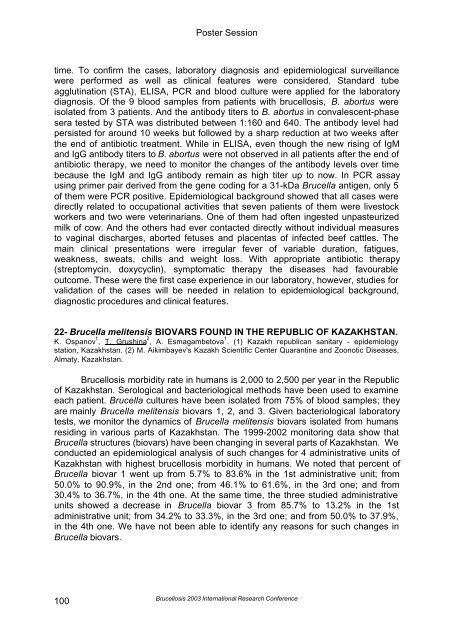Brucellosis 2003 proceedings - PHIDIAS
Brucellosis 2003 proceedings - PHIDIAS
Brucellosis 2003 proceedings - PHIDIAS
You also want an ePaper? Increase the reach of your titles
YUMPU automatically turns print PDFs into web optimized ePapers that Google loves.
Poster Session<br />
time. To confirm the cases, laboratory diagnosis and epidemiological surveillance<br />
were performed as well as clinical features were considered. Standard tube<br />
agglutination (STA), ELISA, PCR and blood culture were applied for the laboratory<br />
diagnosis. Of the 9 blood samples from patients with brucellosis, B. abortus were<br />
isolated from 3 patients. And the antibody titers to B. abortus in convalescent-phase<br />
sera tested by STA was distributed between 1:160 and 640. The antibody level had<br />
persisted for around 10 weeks but followed by a sharp reduction at two weeks after<br />
the end of antibiotic treatment. While in ELISA, even though the new rising of IgM<br />
and IgG antibody titers to B. abortus were not observed in all patients after the end of<br />
antibiotic therapy, we need to monitor the changes of the antibody levels over time<br />
because the IgM and IgG antibody remain as high titer up to now. In PCR assay<br />
using primer pair derived from the gene coding for a 31-kDa Brucella antigen, only 5<br />
of them were PCR positive. Epidemiological background showed that all cases were<br />
directly related to occupational activities that seven patients of them were livestock<br />
workers and two were veterinarians. One of them had often ingested unpasteurized<br />
milk of cow. And the others had ever contacted directly without individual measures<br />
to vaginal discharges, aborted fetuses and placentas of infected beef cattles. The<br />
main clinical presentations were irregular fever of variable duration, fatigues,<br />
weakness, sweats, chills and weight loss. With appropriate antibiotic therapy<br />
(streptomycin, doxycyclin), symptomatic therapy the diseases had favourable<br />
outcome. These were the first case experience in our laboratory, however, studies for<br />
validation of the cases will be needed in relation to epidemiological background,<br />
diagnostic procedures and clinical features.<br />
22- Brucella melitensis BIOVARS FOUND IN THE REPUBLIC OF KAZAKHSTAN.<br />
K. Ospanov 1 , T. Grushina 2 , A. Esmagambetova 1 . (1) Kazakh republican sanitary - epidemiology<br />
station, Kazakhstan. (2) M. Aikimbayev's Kazakh Scientific Center Quarantine and Zoonotic Diseases,<br />
Almaty, Kazakhstan.<br />
<strong>Brucellosis</strong> morbidity rate in humans is 2,000 to 2,500 per year in the Republic<br />
of Kazakhstan. Serological and bacteriological methods have been used to examine<br />
each patient. Brucella cultures have been isolated from 75% of blood samples; they<br />
are mainly Brucella melitensis biovars 1, 2, and 3. Given bacteriological laboratory<br />
tests, we monitor the dynamics of Brucella melitensis biovars isolated from humans<br />
residing in various parts of Kazakhstan. The 1999-2002 monitoring data show that<br />
Brucella structures (biovars) have been changing in several parts of Kazakhstan. We<br />
conducted an epidemiological analysis of such changes for 4 administrative units of<br />
Kazakhstan with highest brucellosis morbidity in humans. We noted that percent of<br />
Brucella biovar 1 went up from 5.7% to 83.6% in the 1st administrative unit; from<br />
50.0% to 90.9%, in the 2nd one; from 46.1% to 61.6%, in the 3rd one; and from<br />
30.4% to 36.7%, in the 4th one. At the same time, the three studied administrative<br />
units showed a decrease in Brucella biovar 3 from 85.7% to 13.2% in the 1st<br />
administrative unit; from 34.2% to 33.3%, in the 3rd one; and from 50.0% to 37.9%,<br />
in the 4th one. We have not been able to identify any reasons for such changes in<br />
Brucella biovars.<br />
100<br />
<strong>Brucellosis</strong> <strong>2003</strong> International Research Conference
















